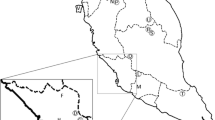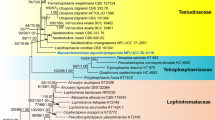Abstract
A new species, Chrysosporium speluncarum, obtained from bat guano in caves in the Czech Republic, Slovakia, and Romania, is described, based on phenotype and rDNA sequences. It possesses tuberculate conidia similar to the Histoplasma anamorph of Ajellomyces capsulatus, but it is not dimorphic, does not grow at 37°C, lacks microconidia, and is nonpathogenic and nonkeratinolytic. All studied characteristics suggest a close relationship with Renispora flavissima. The morphologically similar C. chiropterorum, another species known from the bat environment, is a relative of C. lobatum and Polytolypa hystricis, but is distinct from A. capsulatus and C. speluncarum. The affinity for bats and the presence of conidia with prominent tuberculations has originated convergently in several groups of onygenalean fungi. In addition, the occurrence of fungi mimicking A. capsulatus in caves of temperate Europe is reviewed.



Similar content being viewed by others
Abbreviations
- SGA:
-
Sabouraud’s glucose agar
- MEA:
-
Malt extract agar
- PYE:
-
Phytone yeast extract agar
- CER:
-
Pablum cereal agar
- DSA:
-
Dextrose salts agar
- CCF:
-
Culture Collection of Fungi, Prague
- CMF:
-
Collection of Microscopic Fungi ISB, České Budějovice
- SK:
-
Slovakia
- CZ:
-
The Czech Republic
- RO:
-
Romania
- PRM:
-
Herbarium Mycologicum Musei Nationalis Prague
References
Ajello L, Varsavsky E, Sotgiu G, Mazzoni A, Mantovani A (1965) Survey of soils for human pathogenic fungi from the Emilia-Romagna region of Italy. Mycopathologia 26:65–71
Ajello L, Kuttin ES, Beemer AM, Kaplan W, Padhye A (1977) Occurrence of Histoplasma capsulatum Darling, 1906 in Israel, with a review of the current status of histoplasmosis in the Middle East. Am J Trop Med Hyg 26:140–147
Alteras I (1966) First Romanian isolation of Histoplasma capsulatum from the soil. Derm Inter 5:69–71
Altschul SF, Madden TL, Schaffer AA, Zhang JH, Zhang Z, Miller W, Lipman DJ (1997) Gapped BLAST and PSI-BLAST: a new generation of protein database search programs. Nucleic Acid Res 25:3389–3402
Anonymus (1964) ISCC-NBS Color-Name Charts Illustrated with Centroid Colors. The NBS/IBCC Color System - http://www.anthus.com/Colors.html
Anonymus (2007) Cave-Associated Disease Database. College of Education is one of five colleges at Louisiana Tech University. http://www.latech.edu/tech/education/cavedis/cave-disease-table2_1.html. Accessed 28 June 2009
Balabanoff VA (1967) Etudes comparées des Dermatophytes isolés de grottes et d'étables en Bulgarie. Mycopathologia 32:237–248
Bauder B, Kübber-Heiss A, Steineck T, Kuttin ES, Kaufman L (2000) Granulomatous skin lesions due to histoplasmosis in a badger (Meles meles) in Austria. Med Mycol 38:249–253
Beguin H, Larcher G, Nolard N, Chabasse D (2005) Chrysosporium chiropterorum sp. nov., isolated in France, resembling Chrysosporium state of Ajellomyces capsulatus (Histoplasma capsulatum). Med Mycol 43:161–169
Bosma GC, Custer RP, Bosma MJ (1983) A severe combined immunodeficiency in the mouse. Nature 301:527–530
Campbell CK, Borman AM, Linton CJ, Bridge PD, Johnson EM (2006) Arthroderma olidum, sp. nov. a new addition to the Trichophyton terrestre complex. Med Mycol 44:451–459
Carmichael JW (1962) Chrysosporium and some other aleuriosporic hyphomycetes. Can J Bot 40:1137–1173
Confalonieri M, Nanetti A, Gandola L, Colavecchio A, Aiolfi S, Cannatelli G, Parigi P, Scartabellati A, Porta RD, Mazzoni A (1994) Histoplasmosis capsulati in Italy: autochthonous or imported? Eur J Epidem 10:435–439
Currah RS, Abbott SP, Sigler L (1996) Arthroderma silverae sp. nov. and Chrysosporium vallenarense, keratinophilic fungi from arctic and montane habitats. Mycol Res 100:195–198
de Hoog GS, Guarro J, Gené J, Figueras MJ (2005) Atlas of clinical fungi, 2nd edn. ASM, Utrecht
Dominik T (1967) Chrysosporium Corda. Zeszyty Naukowe Wyzszej Szkoly Rolnicznej w Szczecinie 28:11–32
Domsch KH, Gams W, Anderson T-H (2007) Compendium of soil fungi, 2nd edn. IHW, Eching
Evolceanu R, Alteraş I (1967) A keratinophilic strain of Chrysosporium with outspoken dermatophytic, immunobiologic properties from guano in a cave in Rumania (imperfect stage of Arthroderma multifidum). Mykosen 10:489–492
Farina C, Rizzi M, Ricci L, Gabbi E, Caligaris S, Goglio A (2005) Imported and autochthonous histoplasmosis in Italy: new cases and old problems. Revista Iberoam Micol 22:167–171
Fassatiová O (1986) Moulds and filamentous fungi in technical microbiology. Elsevier, Amsterdam
Garrett SD (1981) Soil fungi and soil fertility, 2nd edn. Pergamon, Oxford
Garrison RG, Mirikitani FK (1983) Fine structural studies of the Chrysosporium state of Renispora flavissima. Mycopathologia 81:3–7
Gaur PK, Lichtwardt RW (1980) Comparative study of a new Chrysosporium species with Histoplasma capsulatum. Sabouraudia 18:105–114
Hall TA (1999) BioEdit: a user-friendly biological sequence alignment editor and analysis program for Windows 95/98/NT. Nucleic Acids S41:95–98
Jensen HE, Bloch B, Henriksen P, Dietz HH, Schonheyder H, Kaufman L (1992) Disseminated histoplasmosis in a badger (Meles meles) in Denmark. Acta Path Micro Im B 100:586–592
Kolařík M, Kostovčík M, Pažoutová S (2007) Mycobiota associated with the ambrosia beetle Scolytodes unipunctatus (Coleoptera: Curculionidae, Scolytinae). Mycol Res 113:44–60
Kreisel H, Schauer F (1987) Methoden des Mykologischen Laboratoriums. Gustav Fischer, Jena
Kumar S, Tamura K, Nei M (2004) MEGA3: Integrated software for molecular evolutionary genetics analysis and sequence alignment. Brief Bioinform 5:150–163
Kushwaha RKS (2000) The genus Chrysosporium its physiology and biotechnological potential. In: Kushwaha RKS, Guarro J (eds) Biology of dermatophytes and other keratinophilic fungi. Rev Iberoam Micol Bilbao, pp 66–76
Larcher G, Bouchara JP, Pailley P, Montfort D, Beguin H, De Bievre C, Chabasse D (2003) Fungal biota associated with bats in Western France. J Mycol Med 13:29–34
Mantovani A (1972) Histoplasmosis in Europe. Ann Soc Belg Med Tr 52:421–434
Mantovani A, Mazzoni A (1971) L’istoplasmosi in Italia. Bull Sci Med (Bologna) 143:57–69
Nováková A (2006a) Microscopic fungi of Chýnov Caves and Na Turoldu Cave (Czech Republic). In: Bella P (ed) Research, utilization and protection of caves, 5th scientific conference with international participation, Demänovská dolina, 26.-29.9.2005, Liptovský Mikuláš, Slovakia, pp 211–213. [In Czech with English abstract]
Nováková A (2006b) Microscopic fungi in the Dobšinská Ice Cave and in selected caves of the Slovak Karst National Park. In: Bella P (ed) Research, utilization and protection of caves, 5th Scientific conference with international participation, Demänovská dolina, 26.-29.9.2005, Liptovský Mikuláš, pp 203–210. [In Czech with English abstract]
Nováková A (2009) Microscopic fungi isolated from the Domica Cave system (Slovak Karst National Park, Slovakia). A review. Int J Speleol 38:71–82
Orr GF (1970) Neogymnomyces: a new genus of the Gymnoascaceae. Can J Bot 48:1061–1066
Rajeev S, Sutton DA, Wickes BL, Miller DL, Giri D, Van Meter M, Thompson EH, Rinaldi MG, Romanelli AM, Cano JF, Guarro J (2009) Isolation and characterization of a new fungal species, Chrysosporium ophiodiicola, from a mycotic granuloma of a black rat snake (Elaphe obsoleta obsoleta). J Clin Microbiol 47:1264–1268
Scott JA, Untereiner WA (2004) Determination of keratin degradation by fungi using keratin azure. Med Mycol 42:239–246
Scott JA, Malloch DW, Gloer JB (1993) Polytolypa, an undescribed genus in the Onygenales. Mycologia 85:503–508
Sigler L, Carmichael JW (1976) Taxonomy of Malbranchea and some other Hyphomycetes with arthroconidia. Mycotaxon 4:349–488
Sigler L, Gaur PK, Lichtwardt RW, Carmichael JW (1979) Renispora flavissima, a new gymnoascaceous fungus with tuberculate Chrysosporium conidia. Mycotaxon 10:133–141
Smith GK (1994) Are you exposing yourself to histoplasmosis? Austral Caver 136:6–8
Smith CD, Furcolow ML (1969) Fifteen isolations of Gymnoascus demonbreunii from canine and soil sources. Sabouraudia 7:142–145
Sotgiu G, Mazzoni A, Mantovani A, Ajello L, Palmer J (1966) Survey of soil for human pathogenic fungi from the Emilia-Romagna region of Italy. II. Isolation of Allescheria boydii, Cryptococcus neoformans and Histoplasma capsulatum. Am J Epidem 83:329–337
Sotgiu G, Mantovani A, Mazzoni A (1970) Histoplasmosis in Europe. Mycopath Mycol Appl 40:53–74
Untereiner WA, Scott JA, Naveau FA, Currah RS, Bachewich J (2002) Phylogeny of Ajellomyces, Polytolypa and Spiromastix (Onygenaceae) inferred from rDNA sequence and non-molecular data. Stud Mycol 47:25–35
Untereiner WA, Scott JA, Naveau FA, Sigler L, Bachewich J, Angus A (2004) The Ajellomycetaceae, a new family of vertebrate-associated Onygenales. Mycologia 96:812–821
van Oorschot CAN (1980) A revision of Chrysosporium and allied genera. Stud Mycol 20:1–89
van Oorschot CAN, Piontelli E (1985) Chrysosporium vallenarense, spec. nov. Persoonia 12:487–488
Vidal P, De los Angeles Vinuesa M, Sanchez-Puelles JM, Guarro J (2000) Phylogeny of the anamorphic genus Chrysosporium and related taxa based on rDNA internal transcribed spacer sequences. Rev Iberoam Micol 17:22–29
Wheat LJ (2003) Current diagnosis of histoplasmosis. Trends Microbiol 11:488–494
Zeller L (1966) Keratinophilic fungi from the Baradla cave in Aggtelek (Biospeologica Hungarica, XXII.). Ann Univ Sci Bud Biol 8:375–388
Zeller L (1968) Chrysosporium species from the “Baradla” cave in Aggtelek (Biospeologica Hungarica XXIV). Mycopathologia 34:296–301
Acknowledgements
This paper is dedicated to Czech mycologist, August J. C. Corda (1809–1894), who described the genus Chrysosporium, on the occasion of the 200th anniversary of his birth. This work was supported by the grant No. AV0Z60660521, MSM 0021620828 and GACR 206/08/P322. We are grateful to the Laboratory of Electron Microscopy of the Institute of Parasitology BC AS CR, v. v. i.) for SEM analysis, to Oleg Ditrich (Institute of Parasitology BC AS CR, v. v. i.) for the pathogenicity assay, to the Cave Administration of the Czech Republic and the Slovak Cave Administration, to Traian Brad (Institute of Speleology E. Racoviţa, Cluj-Napoca) and the management of mentioned caves for allowing entry, to Ľubomír Kováč, Andrej Mock and Peter Ľuptáčik for helping during the collections and to Klára Kochtová for technical assistance.
Author information
Authors and Affiliations
Corresponding author
Rights and permissions
About this article
Cite this article
Nováková, A., Kolařík, M. Chrysosporium speluncarum, a new species resembling Ajellomyces capsulatus, obtained from bat guano in caves of temperate Europe. Mycol Progress 9, 253–260 (2010). https://doi.org/10.1007/s11557-009-0634-0
Received:
Revised:
Accepted:
Published:
Issue Date:
DOI: https://doi.org/10.1007/s11557-009-0634-0




